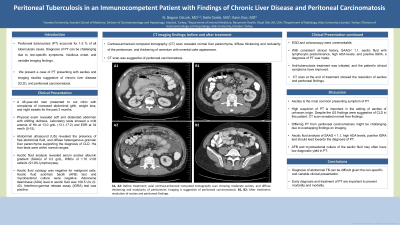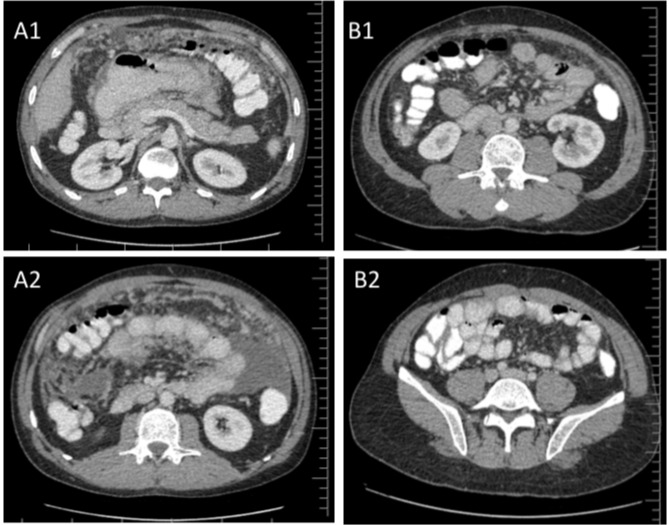Back


Poster Session A - Sunday Afternoon
Category: Liver
A0517 - Peritoneal Tuberculosis in an Immunocompetent Patient With Findings of Chronic Liver Disease and Peritoneal Carcinomatosis
Sunday, October 23, 2022
5:00 PM – 7:00 PM ET
Location: Crown Ballroom

Has Audio

Nazli Begum Ozturk, MD
Istanbul University, Istanbul School of Medicine
Istanbul, Turkey
Presenting Author(s)
Nazli Begum Ozturk, MD1, Naile Dolek, MD2, Raim Iliaz, MD2
1Istanbul University, Istanbul School of Medicine, Rochester, MN; 2Atlas University School of Medicine, Istanbul, Istanbul, Turkey
Introduction: Peritoneal tuberculosis (PT) accounts for 1-2% of all tuberculosis cases. Diagnosis of PT can be challenging due to non-specific symptoms, insidious onset, and variable imaging findings. We present a case of PT presenting with ascites and imaging studies suggestive of chronic liver disease (CLD), and peritoneal carcinomatosis.
Case Description/Methods: A 48-year-old man presented to our clinic with complaints of increased abdominal girth, weight loss, and night sweats for the past 3 months. Physical exam revealed soft and distended abdomen with shifting dullness. Laboratory tests showed a mild anemia of Hb at 13.0 g/dL (13.1-17.2) and ESR at 34 mm/h (0-15). Abdominal ultrasound (US) revealed the presence of free abdominal fluid, and diffuse heterogenous granular liver parenchyma supporting the diagnosis of CLD. His liver tests were within normal ranges. Ascitic fluid analysis revealed serum ascites albumin gradient (SAAG) of 0.2 g/dL, WBCs of 1.70 x103 cells/dL (91.8% lymphocytes). Ascitic fluid cytology was negative for malignant cells. Ascitic fluid acid-fast bacilli (AFB) test and mycobacterial culture were negative. Adenosine deaminase (ADA) level in ascitic fluid was 108.5 U/L (0-40). Interferon-gamma release assay (IGRA) test was positive. Contrast-enhanced computed tomography (CT) scan revealed normal liver parenchyma, diffuse thickening and nodularity of the peritoneum, and thickening of omentum with omental cake appearance. CT scan was suggestive of peritoneal carcinomatosis. EGD and colonoscopy were unremarkable. With consistent clinical history, SAAG< 1.1, ascitic fluid with lymphocytic predominance, high ADA levels, and positive IGRA, a diagnosis of PT was made. Anti-tuberculosis treatment was initiated, and the patient’s clinical symptoms have improved. CT scan at the end of treatment showed the resolution of ascites and peritoneal findings.
Discussion: Ascites is the most common presenting symptom of PT. High suspicion of PT is important in the setting of ascites of unknown origin. Despite the US findings were suggestive of CLD in this patient, CT scan revealed normal liver findings. Differing PT from peritoneal carcinomatosis might be challenging due to overlapping findings on imaging. Ascitic fluid analysis of SAAG < 1.1, high ADA levels, positive IGRA test should lead towards the diagnosis of PT. AFB and mycobacterial culture of the ascitic fluid may often have low diagnostic yield in PT. Early diagnosis and treatment are important to prevent complications.

Disclosures:
Nazli Begum Ozturk, MD1, Naile Dolek, MD2, Raim Iliaz, MD2. A0517 - Peritoneal Tuberculosis in an Immunocompetent Patient With Findings of Chronic Liver Disease and Peritoneal Carcinomatosis, ACG 2022 Annual Scientific Meeting Abstracts. Charlotte, NC: American College of Gastroenterology.
1Istanbul University, Istanbul School of Medicine, Rochester, MN; 2Atlas University School of Medicine, Istanbul, Istanbul, Turkey
Introduction: Peritoneal tuberculosis (PT) accounts for 1-2% of all tuberculosis cases. Diagnosis of PT can be challenging due to non-specific symptoms, insidious onset, and variable imaging findings. We present a case of PT presenting with ascites and imaging studies suggestive of chronic liver disease (CLD), and peritoneal carcinomatosis.
Case Description/Methods: A 48-year-old man presented to our clinic with complaints of increased abdominal girth, weight loss, and night sweats for the past 3 months. Physical exam revealed soft and distended abdomen with shifting dullness. Laboratory tests showed a mild anemia of Hb at 13.0 g/dL (13.1-17.2) and ESR at 34 mm/h (0-15). Abdominal ultrasound (US) revealed the presence of free abdominal fluid, and diffuse heterogenous granular liver parenchyma supporting the diagnosis of CLD. His liver tests were within normal ranges. Ascitic fluid analysis revealed serum ascites albumin gradient (SAAG) of 0.2 g/dL, WBCs of 1.70 x103 cells/dL (91.8% lymphocytes). Ascitic fluid cytology was negative for malignant cells. Ascitic fluid acid-fast bacilli (AFB) test and mycobacterial culture were negative. Adenosine deaminase (ADA) level in ascitic fluid was 108.5 U/L (0-40). Interferon-gamma release assay (IGRA) test was positive. Contrast-enhanced computed tomography (CT) scan revealed normal liver parenchyma, diffuse thickening and nodularity of the peritoneum, and thickening of omentum with omental cake appearance. CT scan was suggestive of peritoneal carcinomatosis. EGD and colonoscopy were unremarkable. With consistent clinical history, SAAG< 1.1, ascitic fluid with lymphocytic predominance, high ADA levels, and positive IGRA, a diagnosis of PT was made. Anti-tuberculosis treatment was initiated, and the patient’s clinical symptoms have improved. CT scan at the end of treatment showed the resolution of ascites and peritoneal findings.
Discussion: Ascites is the most common presenting symptom of PT. High suspicion of PT is important in the setting of ascites of unknown origin. Despite the US findings were suggestive of CLD in this patient, CT scan revealed normal liver findings. Differing PT from peritoneal carcinomatosis might be challenging due to overlapping findings on imaging. Ascitic fluid analysis of SAAG < 1.1, high ADA levels, positive IGRA test should lead towards the diagnosis of PT. AFB and mycobacterial culture of the ascitic fluid may often have low diagnostic yield in PT. Early diagnosis and treatment are important to prevent complications.

Figure: A1, A2: Before treatment; axial contrast-enhanced computed tomography scan showing moderate ascites, and diffuse thickening and nodularity of peritoneum. Imaging is suggestive of peritoneal carcinomatosis.
B1, B2: After treatment; resolution of ascites and peritoneal findings.
B1, B2: After treatment; resolution of ascites and peritoneal findings.
Disclosures:
Nazli Begum Ozturk indicated no relevant financial relationships.
Naile Dolek indicated no relevant financial relationships.
Raim Iliaz indicated no relevant financial relationships.
Nazli Begum Ozturk, MD1, Naile Dolek, MD2, Raim Iliaz, MD2. A0517 - Peritoneal Tuberculosis in an Immunocompetent Patient With Findings of Chronic Liver Disease and Peritoneal Carcinomatosis, ACG 2022 Annual Scientific Meeting Abstracts. Charlotte, NC: American College of Gastroenterology.
